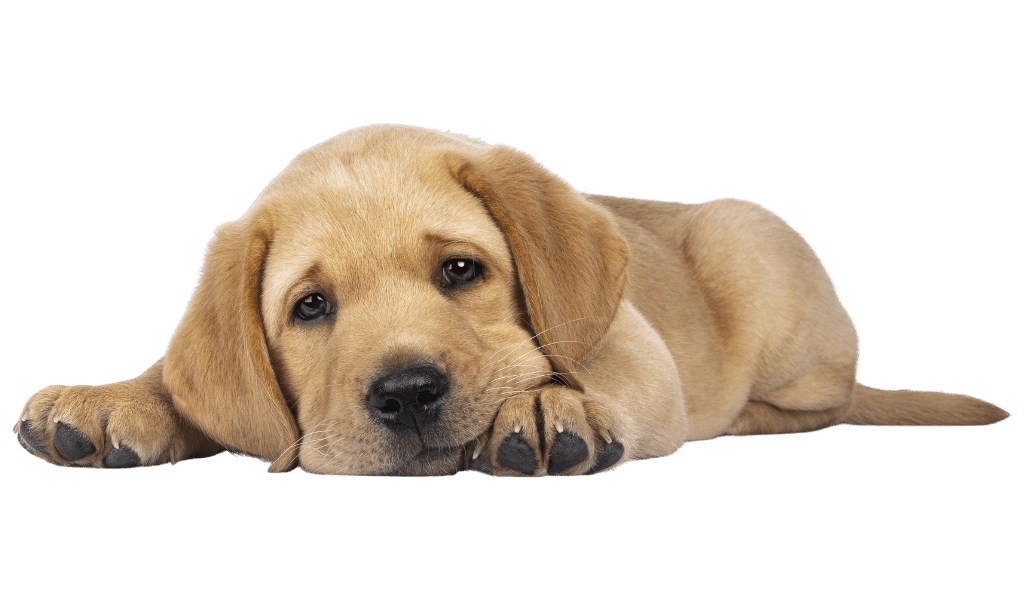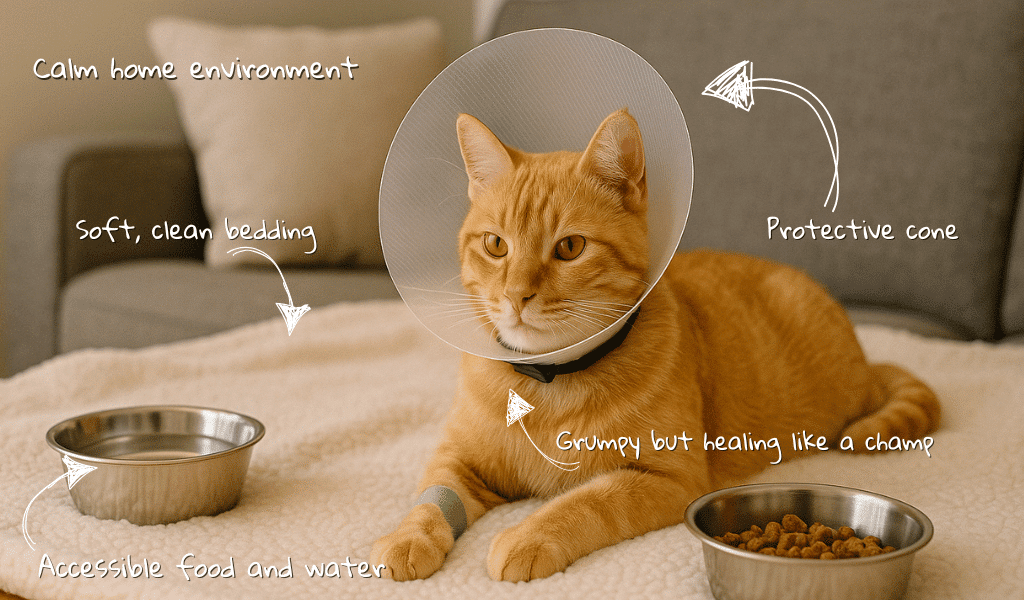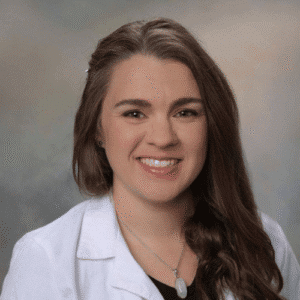How to Help Your Pet Recover After Surgery

Creating a Comfortable Recovery Space
It’s important to offer your pet a quiet, calm, and warm area to recover from surgery, ideally a place they are used to being in. This can be a specific room, crate, cage, or other area that they feel comfortable in. Use soft, clean bedding, and provide easy access to food and water. If they cannot walk very easily, this may mean putting their food and water very near to them where they can get to it, or offering it to them by hand at regular intervals. It’s also important to find solutions to ways to give them their medications, and may include novel, high-value food items your pet regularly enjoys. At Caring Hands, our expert staff can help you if you have questions or difficulties giving medications.

Key Tips for Creating a Recovery Space
- Choose a quiet, familiar area like a crate or comfy room
- Use soft, clean bedding to support healing
- Keep food and water easily accessible
- Offer meals by hand if mobility is limited
- Use high-value treats to help with medication
- Reach out to our staff for medication support
Managing Pain and Discomfort
Managing pain and inflammation is crucial for ensuring a speedy recovery – pain induces stress, which can slow down the healing process. So it’s vitally important to know if your pet is in more pain than they should be. This can be difficult to assess, as animals are notoriously hard to read when it comes to showing physical signs of pain. That’s also why it’s important to give pain medications exactly as prescribed by your veterinarian.
Your vet may prescribe one or more medications to manage pain, including anti-inflammatories (usually an NSAID) and other stronger medications, depending on the type of pain your pet is experiencing. This is called a “multi-modal” pain approach, and is currently the most effective way to treat acute pain and prevent chronic, long-term pain.
Common Signs of Pain in Cats
After surgery your cat may display some common signs of pain, watch for the following:
- Changes in routine
- Hiding behavior
- Sitting hunched or bunched up
- Droopy ears
- Closed or squinted eyes
- Reluctance to move
- Growling or hissing at being approached or touched
Common Signs of Pain in Dogs
After surgery your dog may display some common signs of pain, watch for the following:
- Restlessness
- Panting
- Whimpering
- Droopy ears
- Unwilling to move
Monitoring Your Pet’s Incision Site
Monitoring your pet’s incision is crucial. With clean or gloved hands, you can gently inspect the surgical site for any signs of redness, swelling, or discharge, as these could indicate infection. Avoid touching the incision directly, as this could be painful or introduce unnecessary bacteria to the wound.
Do not apply any ointment or creams to the wound, even if you do suspect an infection. Incisions heal best when left alone. This includes keeping them clean and dry, which is why we discourage bathing your pet until at least 3 weeks after the procedure. If the area does happen to become superficially dirty, you can clean the area with warm water and a washcloth. If you notice anything unusual, be sure to contact your vet.
For a detailed timeline and tips on managing your pet’s activity, be sure to read our guide on surgery recovery tips.

Encouraging Gentle Activity
It’s also important to limit your pet’s physical activity, keep them calm and prevent running, jumping, or any vigorous movement that could interfere with their healing process.
Keeping your pet mentally stimulated during recovery can be challenging, especially in the first week after recovery when they are starting to feel better, but are not yet able to go run and play like they normally would. Quiet mental stimulation can help with this, and includes activities such as treat puzzles or safely destructive toys (with supervision).
Eventually, you will be able to re-introduce more normal exercise and activity, starting with short walks and increasing to off-leash play, depending on the parameters of the procedure and recovery timeline. Ongoing pet wellness care can help guide this transition and ensure your pet stays healthy long after recovery.
At Caring Hands, we will provide you with a recommended recovery schedule to help ensure success of the procedure and enable your pet to return to normal as quickly as possible.
Sometimes, temporary anxiety medications or mild sedatives are needed to keep active and playful animals calm during recovery. Your vet will discuss this with you if they think it’s important to your pet’s recovery strategy.

Common Challenges and How to Address Them
Common post-surgical challenges for pets owners to deal with can include licking or chewing the incision, loss of appetite, and anxiety or restlessness. To prevent your pet from irritating the surgical site, it’s essential to use an Elizabethan collar (e-collar) or a recovery suit, which will help keep them from licking or chewing at the incision. However, if you choose a recovery suit, be sure to discuss this with your vet to make sure the fabric doesn’t rub or catch on the incision, which can cause incision issues as was described previously.
If your pet is experiencing a loss of appetite, try offering small, frequent meals or tempting them with wet food or their favorite treats, but always consult your vet first to ensure it’s appropriate. High-fat foods like cheese or ground burger can be upsetting to the GI system during recovery. For specific surgeries, such as any involving the stomach or intestines, your veterinarian will tell you what type of foods to stick to during recovery and for how long.
Pets struggling with anxiety or restlessness can either be suffering from discomfort (pain), or boredom. In which case, these should be treated differently. If your pet is bored, try giving them calming toys, pheromone sprays (this works particularly well for cats), or play gentle music to help create a soothing environment. If these measures aren’t enough, anxiety medications may be prescribed by your vet.
It’s also important to check that your pet is receiving adequate pain management, which can make a significant difference in their comfort level during recovery. Ensure you are giving your pet the proper pain medications prescribed, and if you feel like they are not enough, call your veterinarian to see what they recommend. They may prescribe you a higher dose or different medications in combination to the ones already being given. Addressing these challenges with the right tools and veterinary guidance can help make the recovery process smoother for both you and your pet
Quick Tips for Handling Common Recovery Challenges
- Licking or chewing the incision:
- Use an e-collar (cone) or recovery suit
- Always check with your vet before using a recovery suit to avoid friction on the incision
- Loss of appetite:
- Offer small, frequent meals or tempting wet food/treats
- Avoid high-fat foods like cheese or ground burger
- Follow your vet’s dietary instructions, especially after GI-related surgeries
- Anxiety or restlessness:
- Bored? Try calming toys, pheromone sprays (great for cats), or soft music
- In pain? Ensure proper use of prescribed pain meds
- If symptoms persist, consult your vet about anxiety or pain management adjustments
- Dental discomfort:
- Oral pain can contribute to appetite loss—especially after certain surgeries
- If you suspect dental issues, check out our Pet Dental Care page or contact your us
Post-Surgery Support for Pets in Billings, MT
When Should You Contact Your Vet?
If you have questions or concerns or need to schedule a pet surgery or follow-up appointment our team at Caring Hands Veterinary Hospital in Billings, MT is here to help. We proudly support pet owners throughout Billings, Lockwood, Laurel, and the surrounding areas with personalized post-surgical care and guidance.
Even if your pet’s surgery was performed at another clinic, we’re happy to assist with recovery support, wound checks, and medication questions.
Let’s Make Recovery Easier—for Both of You
Call Our Caring Team
We're here to answer your post-surgery questions and help you schedule care.
Book Online Anytime
Whether it's surgery, a recheck, or general advice—we’ve made booking simple.
About the Author

Dr. Erin Maxted, DVM
Dr. Maxted is a veterinarian at Caring Hands vet here in Billings Montana with a background in veterinary tech work and a passion for internal medicine, sports medicine, and conservation. She brings a decade of hands-on experience to every patient she sees.

Dr. Erin Maxted, DVM
Dr. Maxted is a veterinarian at Caring Hands vet here in Billings Montana with a background in veterinary tech work and a passion for internal medicine, sports medicine, and conservation. She brings a decade of hands-on experience to every patient she sees.